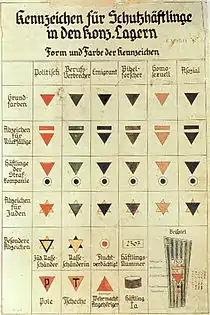
| Part of the LGBT series |
| LGBT symbols |
|---|
| Symbols |
| Pride flags |
The inverted black triangle (German: schwarzes Dreieck) was an identification badge used in Nazi concentration camps to mark prisoners designated asozial ("asocial")[1][2] and arbeitsscheu ("work-shy"). The Roma and Sinti people were considered asocial and tagged with the black triangle.[1][3] The designation also included alcoholics, beggars, homeless people, nomads, prostitutes, and violators of laws prohibiting sexual relations between Aryans and Jews.[1][2] Women also deemed to be anti-social included nonconformists.[2][4]
Usage

Nazi
The symbol originates from Nazi Germany, where every prisoner had to wear a concentration camp badge on their prison clothes, of which the design and color categorized them according to the reason for their internment. The homeless were included, as were alcoholics, those who habitually avoided labor and employment, draft evaders, pacifists, Roma and Sinti people, and others.[5][6]
Romani
Romani first wore the black triangle with a Z notation (for Zigeuner, meaning Gypsy) to the right of the triangle's point.[7] Male Romani were later assigned a brown triangle. Female Romani were still deemed asocials as they were stereotyped as petty criminals (prostitutes, kidnappers and fortune tellers).
Disabled people
Some UK groups concerned with the rights of disabled people have adopted the symbol in their campaigns.[8][9] Such groups cite press coverage and government policies, including changes to incapacity benefits and disability living allowance, as the reasons for their campaigns.[10][11] "The Black Triangle List" was created to keep track of welfare-related deaths due to cuts by the Department for Work and Pensions.[12]
See also
References
- 1 2 3 "System of triangles". Auschwitz-Birkenau State Museum.
- 1 2 3 Elman, Amy (Winter 1996–97). "Triangles and Tribulations: The Gay Appropriation of Nazi Symbols" (PDF). Trouble & Strife (34): 62–66. Retrieved 10 June 2021.
An earlier version of this article appeared in Journal of Homosexuality, Vol. 30, issue 3, 1996.
(doi:10.1300/J082v30n03_01. PMID 8743114. ISSN 0091-8369.) - ↑ "Roma and Sinti (Gypsies) Prisoners". Priddy Library. Universities at Shady Grove.
- ↑ Heineman, Elizabeth D. (2002). "Sexuality and Nazism: The Doubly Unspeakable?". Journal of the History of Sexuality. 11 (1/2): 22–66. doi:10.1353/sex.2002.0006. ISSN 1043-4070. JSTOR 3704551. S2CID 142085835.
- ↑ "The unsettled, "asocials"". Holocaust and Genocide Studies. University of Minnesota. 2007. Archived from the original on 4 June 2008. Retrieved 14 September 2012.
- ↑ "Asocials". Holocaust Memorial Day Trust. Ministry of Housing, Communities and Local Government. Retrieved 23 June 2020.
- ↑ "Glossary". jewishvirtuallibrary.org. Retrieved 27 March 2018.
- ↑ "About Black Triangle". Black Triangle Campaign. March 2012.
- ↑ "About". Disabled People Against Cuts. 2010.
- ↑ Sue Marsh (20 December 2011). "No disability living allowance for me. Nowhere to turn for many more". Black Triangle Campaign.
- ↑ George Monbiot (12 December 2011). "Britain's press are fighting a class war, defending the elite they belong to". Black Triangle Campaign.
- ↑ Laws, Vince (30 April 2015). "UK Welfare-Related Deaths: The Black Triangle List". Disability Arts Online. Retrieved 30 July 2018.
Further reading
- "Lesbians Under the Nazi Regime". Holocaust Encyclopedia. United States Holocaust Memorial Museum. 31 March 2021.
- Marshall, Stuart. "The Contemporary Use of Gay History: The Third Reich," in Bad-Object Choices (ed.), How Do I Look? Queer Film and Video, Seattle, Wash.: Bay Press, 1991.